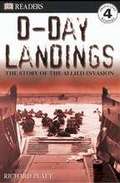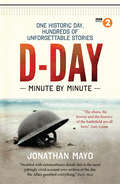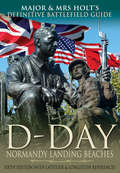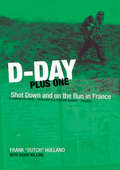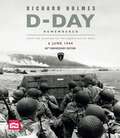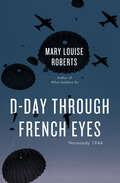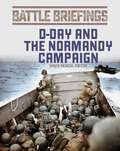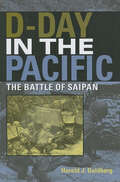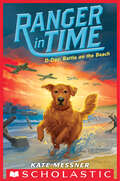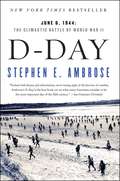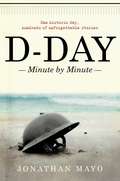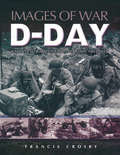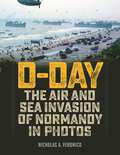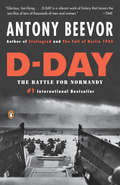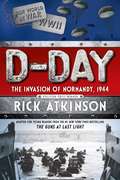- Table View
- List View
D-Day Landings: The Story of the Allied Invasion
by Karen Wallace Richard PlattHow did the Allies plan and execute the most massive and daring invasion in military history? Read all about it in the DK Reader that explains in thrilling detail how the Nazis were defeated on the beaches of France. DK Readers is a multi-level learning-to-read program combining DK's highly visual style with appealing stories at five graduated levels. Stunning photographs and engaging, age-appropriate stories are guaranteed to capture a child's interest while developing reading skills and general knowledge. DK Readers allow progression of stories for beginning readers with simple sentences and word repetition through to stories with rich vocabulary and more challenging sentence structure for proficient readers.
D-Day Minute By Minute: One historic day, hundreds of unforgettable stories (Minute By Minute)
by Jonathan MayoThe invasion has begun. In this gripping book, Jonathan Mayo gives a blow by blow account of the events of D-Day, revealing what happened to the people swept up in this crucial moment in history. From soldiers, French villagers and journalists, to schoolchildren and nurses, thousands were placed in extraordinary situations when the Allies landed in Normandy. This is their story.
D-Day Normandy Landing Beaches: Sixth Edition with Latitude and Longitude References (Major & Mrs Holt's Definitive Battlefield Guide)
by Tonie Holt Valmai HoltAn extensive traveler&’s guide to the French region&’s World War II historical sites and everything else you need to know about the area. Already the best-selling English-language guide to the area, universally known as &“the Bible,&” this is the sixth, completely revised, up-to-date, much expanded edition of the Definitive Guide to the D-Day Normandy Landing Beaches. The third in the Holts&’ important series of Battlefield Guides (following the Somme and the Ypres Salient), it employs the same, highly acclaimed formula. Once again, the cold facts are interlaced with anecdotes of bravery, humor, sadness, and humanity. This new edition now contains all the landing beaches: Juno, Sword, Gold, Omaha, Utah; all the airborne operations: British and American two approach routes; six timed and measured itineraries; 21 in-text itinerary maps, battle maps & diagrams; and approximately 400 recommended sites within the D-Day planned area of advance, all with photos, each with latitude & longitude references (New for this Edition). It features over 400 colored pictures and 352 pages of memorials, museums, batteries, bunkers, landing fields, historical background to the landings, the plans and what actually happened, information about Allied and German war graves, veterans&’ associations, and other commemorative associations. It also has Normandy tourist information about where to stay and to eat, and information about historical figures such as recipients of the Victoria Cross and the Medal of Honor, poets, photographers, and more.
D-Day Plus One: Shot Down and on the Run in France
by Frank Holland Adam WilkinsA World War II RAF veteran tells the dramatic story of D-Day, his survival after being shot down by the Germans, and his journey back to Allied lines. The day after D-Day, the most momentous day of the Second World War, Frank Holland was an RAF pilot whose Typhoon aircraft had just been hit by German antiaircraft fire during a low flying attack on a marshaling yard in Normandy. He managed to take the aircraft up to 1200 feet but then the engine went dead and his Typhoon soon began heading towards the earth at an accelerating and frightening speed. Struggling frantically, he just barely got free of the cockpit and baled out four or five seconds before the crash. His parachute didn&’t open but he fell into a wood, crashing through the branches of an oak to dangle precariously fifteen feet up. Breathing hard, he experienced a few seconds of relief at survival. But then he realized German troops would be swarming around within minutes. He had to get away, and fast . . . So begins Frank&’s tremendous adventure as he evaded capture for months, sometimes by barely a whisker, to make it back home to the city of his birth, Cambridge. A riveting true story told in a masterly fashion.
D-Day Remembered: From the Invasion to the Liberation of Paris
by Richard Holmes Imperial War Museum80th ANNIVERSARY EDITIONProduced in collaboration with Imperial War MuseumsRelive the day that changed the course of history. On 6 June 1944, D-Day marked the beginning of a campaign that involved more than a million men and helped seal the fate of Hitler's Germany.Written by esteemed military historian Richard Holmes and including rare documents, diaries and secret memos from the archives of the Imperial War Museums, D-Day Remembered details the planning, execution and aftermath of the most momentous event of the Second World War.
D-Day Remembered: From the Invasion to the Liberation of Paris
by Richard Holmes Imperial War Museum80th ANNIVERSARY EDITIONProduced in collaboration with Imperial War MuseumsRelive the day that changed the course of history. On 6 June 1944, D-Day marked the beginning of a campaign that involved more than a million men and helped seal the fate of Hitler's Germany.Written by esteemed military historian Richard Holmes and including rare documents, diaries and secret memos from the archives of the Imperial War Museums, D-Day Remembered details the planning, execution and aftermath of the most momentous event of the Second World War.
D-Day Through French Eyes: Normandy 1944
by Mary Louise Roberts&“A moving examination of how French civilians experienced the fighting&” at Normandy during WWII from the acclaimed author of What Soldiers Do (Telegraph, UK). &“Like big black umbrellas, they rain down on the fields across the way, and then disappear behind the black line of the hedges.&” Silent parachutes dotting the night sky—that&’s how one Normandy woman learned that the D-Day invasion was under way in June of 1944. Though they yearned for liberation, the French had to steel themselves for war, knowing that their homes, lands, and fellow citizens would have to bear the brunt of the attack. With D-Day through French Eyes, Mary Louise Roberts turns the conventional narrative of D-Day on its head, taking readers across the Channel to view the invasion anew. Roberts builds her history from an impressive range of gripping first-person accounts by French citizens throughout the region. A farm family notices that cabbage is missing from their garden—then discovers that the guilty culprits are American paratroopers hiding in the cowshed. Fishermen rescue pilots from the wreck of their B-17, then search for clothes big enough to disguise them as civilians. A young man learns to determine whether a bomb is whistling overhead or silently plummeting toward them. When the allied infantry arrived, French citizens guided them to hidden paths and little-known bridges, giving them crucial advantages over the German occupiers. As she did in her acclaimed account of GIs in postwar France, What Soldiers Do, Roberts here sheds vital new light on a story we thought we knew. "In the great tradition of Studs Terkel and Is Paris Burning?, Mary Louise Roberts uses the diaries and memoirs of French civilians to narrate a history of the French at D-Day that has for too long been occluded by the mythology of the allied landing.&”—Alice Kaplan, author of Dreaming in French
D-Day To Berlin
by Andrew WilliamsNightfall, 6 June 1944. D-Day is over and the Allies have carved a tenuous foothold in 'Fortress Europe'. The future of Europe hangs in the balance as Hitler's formidable SS Panzer troops threaten to drive them back into the sea. D-Day to Berlin is the remarkable story of the Allied struggle for survival - the battle from the beaches of Normandy to the heart of Hitler's Reich and ultimate victory just eleven months later. The campaign to free Europe from Nazi oppression through the collective operations from D-Day to Berlin mark one of the greatest ever military offensives. The Allies overcame initial setbacks to inflict a devastating defeat on Hitler's crack divisions in France - a victory that was threatened just months later in the bitter winter fighting of the Battle of the Bulge. The final crossing of the Rhine and the advance into Germany changed the course of European history forever. In D-Day to Berlin we meet men and women from both sides - British, American and German soldiers - whose bravery and endurance made the final push through Europe the defining drama of the Second World War.
D-Day To Berlin
by Andrew WilliamsNightfall, 6 June 1944. D-Day is over and the Allies have carved a tenuous foothold in 'Fortress Europe'. The future of Europe hangs in the balance as Hitler's formidable SS Panzer troops threaten to drive them back into the sea. D-Day to Berlin is the remarkable story of the Allied struggle for survival - the battle from the beaches of Normandy to the heart of Hitler's Reich and ultimate victory just eleven months later. The campaign to free Europe from Nazi oppression through the collective operations from D-Day to Berlin mark one of the greatest ever military offensives. The Allies overcame initial setbacks to inflict a devastating defeat on Hitler's crack divisions in France - a victory that was threatened just months later in the bitter winter fighting of the Battle of the Bulge. The final crossing of the Rhine and the advance into Germany changed the course of European history forever. In D-Day to Berlin we meet men and women from both sides - British, American and German soldiers - whose bravery and endurance made the final push through Europe the defining drama of the Second World War.
D-Day and the Normandy Campaign (Battle Briefings)
Stackpole&’s Battle Briefings series offers accessible and insightful summaries of battles, commanders, and other military history topics. This inaugural installment features one of World War II&’s most pivotal campaigns: D-Day and the battle for Normandy that followed. It begins with Allied plans for the beachhead assault and Rommel&’s construction of German defenses, but the book&’s heart is the fighting as seen from both sides, from the Rangers at Pointe du Hoc and the landing at Omaha Beach to hedgerow combat, the air war, and clashes of Shermans and panzers.
D-Day in the Pacific: The Battle of Saipan (Twentieth-Century Battles)
by Harold J. Goldberg“The narrative moves smoothly and crisply. There is effective treatment of strategy, preparations, and then the invasion and battle for Saipan itself.” —Spencer C. Tucker, author of American RevolutionIn June 1944 the attention of the nation was riveted on events unfolding in France. But in the Pacific, the Battle of Saipan was of extreme strategic importance. This is a gripping account of one of the most dramatic engagements of World War II. The conquest of Saipan and the neighboring island of Tinian was a turning point in the war in the Pacific as it made the American victory against Japan inevitable. Until this battle, the Japanese continued to believe that success in the war remained possible. While Japan had suffered serious setbacks as early as the Battle of Midway in 1942, Saipan was part of her inner defense line, so victory was essential. The American victory at Saipan forced Japan to begin considering the reality of defeat. For the Americans, the capture of Saipan meant secure air bases for the new B-29s that were now within striking distance of all Japanese cities, including Tokyo.“Harold Goldberg’s riveting story of this conflict brings the dead back to life by blending rigorous research with dramatic narratives by hundreds of survivors. He has written a superb account of a pivotal, little-known, and heart-breaking battle.” —Col. Joseph H. Alexander, USMC (ret.),author of Storm Landings“Using recent interviews he conducted with extant US veterans, [Goldberg] skillfully develops the soldiers’ view of the battle for Saipan in an engaging, clearly written and interesting volume.” —The Journal of Military History
D-Day to Victory
by Stephen Bull Impossible PicturesBeginning with a look at D-Day itself, this book begins by analyzing the deadly fighting on the beaches as the Allies launched the first successful cross-Channel invasion in 900 years and concludes with the final victory amidst the ruins of Berlin. Now, almost 70 years afterwards, this book reveals the realities of the final year of the war through the words and recollections of the last surviving veterans. Using their own words and accounts it describes the terror of soldiers facing down a German tank, assaulting a machine-gun post or surviving an artillery barrage on the long, arduous road to Victory-in-Europe. Drawing upon expert analysis and no-holds-barred recreations, it also shows the devastating effects of the weaponry used on a daily basis in an astonishing sequence of full-colour images while historic imagery bring to life the last great battles between the Allies and Nazi Germany from the torturous struggle for control of Falaise to the desperate fighting in the Bulge and the final push to the heart of the Reich. Like no other book before, World War II Frontline Heroes, reveals how ordinary men and women fought and survived throughout the extraordinary final months of World War II.
D-Day to Victory
by Stephen BullAn eye-popping, innovative approach to one of the most-popular topics in all of history: the European Theater of World War II. The myth-busting designers of this unique book will provide readers with a full account of the campaign to liberate Europe sprinkled throughout with more than 200 unequalled visual assets. Based-on the 6-part mini-series coming from BBC Channel 4 in the UK and History TV in Canada. Includes extensive interviews with WWII veterans such as Col. Edward D. Shames who fought with the legendary 'Band of Brothers' of "E" Company, 2/506, 101st Airborne.
D-Day with the Screaming Eagles
by George KoskimakiA collection of eyewitness accounts of the Normandy landings that &“gives you the [feeling] that you are there during the frenzied first hours of the invasion&” (Kepler&’s Military History Book Reviews). Many professional historians have recorded the actions of D-Day but here is an account of the airborne actions as described by the actual men themselves, in eyewitness detail. Participants range from division command personnel to regimental, battalion, company, and battery commanders, to chaplains, surgeons, enlisted medics, platoon sergeants, squad leaders and the rough, tough troopers who adapted quickly to fighting in mixed, unfamiliar groups after a badly scattered drop. And yet they managed to gain the objectives set for them in the hedgerow country of Normandy. This book is primary source material. It is a &“must read&” for anyone interested in the Normandy landings, the 101st Airborne Division, and World War II in general. Hearing the soldiers speak is an entirely different experience from reading about the action in a narrative history.
D-Day, Arnhem & the Rhine: A Glider Pilot’s Memoir
by Robert F. AshbyFoot soldiers, commandos, parachutists, naval seamen, bomber and fighter pilots – their varied personal experiences of the Second World War have been widely recounted, and the parts they played in the conflict are well known. But there are specialized wartime roles that have received very little attention, notably the gallant actions of the men of the Glider Pilot Regiment. That is why Robert Ashby’s rare and vivid pilot’s memoir is so valua-ble. In it he offers a fascinating insight not only into the major operations he took part in – including D-Day, Arnhem and the Rhine crossing – but into the exacting flying skills required to carry out perilous glider landings on enemy territory while under fire. His account of his hair-raising training, together with his pen-portraits of his comrades and officers, takes the reader inside the world of a ‘citizen soldier’. The glider landings at Arnhem and the intense fighting that followed are the climax of his narrative, offering us a remarkable insight into one of the most controversial Allied disasters of the entire war.
D-Day: Battle On The Beach (Ranger in Time #7)
by Kate MessnerIn this historical adventure novel for middle grade readers, a dog travels through time to join the allied forces in the Battle of Normandy.Ranger, the time-traveling golden retriever with search and rescue skills, heads to Normandy on the morning of the D-Day invasion and finds himself in the middle of one of the fiercest battles of World War II. Ranger meets Leo, a Jewish boy who is hiding with a local farmer, and Walt, a young African-American soldier fighting to free France from the Nazis. It’s pure chaos, with thundering warplanes, falling bombs, and exploding land mines. Will Ranger, Leo, and Walt survive?
D-Day: June 6, 1944: The Climactic Battle of World War II (Core Ser.)
by Stephen E. Ambrose<p>Stephen E. Ambrose draws from more than 1,400 interviews with American, British, Canadian, French, and German veterans to create the preeminent chronicle of the most important day in the twentieth century. Ambrose reveals how the original plans for the invasion were abandoned, and how ordinary soldiers and officers acted on their own initiative. <p><i>D-Day</i> is above all the epic story of men at the most demanding moment of their existence, when the horrors, complexities, and triumphs of life are laid bare. Ambrose portrays the faces of courage and heroism, fear and determination -- what Eisenhower called "the fury of an aroused democracy" -- that shaped the victory of the citizen soldiers whom Hitler had disparaged.</p>
D-Day: Juno Beach, Canada's 24 Hours of Destiny
by Lance GoddardMany have called it the most important event of the twentieth century - and Canada played a key role. When Canadian troops landed at Juno Beach, they faced some of the fiercest opposition of the attack, and yet they managed to advance further inland than all the other Allied forces. D-Day: Juno Beach, Canada’s 24 Hours of Destiny chronicles that momentous day hour-by-hour, through the words of the men themselves. With more than 300 illustrations, this is a vivid remembrance of one of Canada’s greatest military achievements.
D-Day: Minute by Minute
by Jonathan Mayo<p>Told in a purely chronological style, this fascinating account vividly details the authentic stories of regular people caught up in the historical events of D-Day. <p>June 6, 1944 was a truly historic day, but it was also a day where ordinary people found themselves in extraordinary situations... Lieutenant Norman Poole jumped from a bomber surrounded by two hundred decoy dummy parachutists. French baker Pierre Cardron led British paratroopers to his local church, where he knew two German soldiers were hiding in the confessional. Southampton telegram boy Tom Hiett delivered his first "death message" by midday. At the sound of Allied aircraft, Werner Kortenhaus of the twenty-first Panzer Division ran to collect his still damp washing from a French laundrywoman. And injured soldiers wept in their beds in a New York hospital, knowing that their buddies lay dying on the Normandy beaches. <p>Drawing on memoirs, diaries, letters, and oral accounts, <i>D-Day</i> is a purely chronological narrative, concerned less with the military strategies and more with what people were thinking and doing as D-Day unfolded, minute-by-minute. Moving seamlessly from various perspectives and stories, <i>D-Day</i> sets the reader in the midst of it all, compelling us to relive this momentous day in world history.</p>
D-Day: Minute by Minute
by Jonathan MayoTold in a purely chronological style, this fascinating account vividly details the authentic stories of regular people caught up in the historical events of D-Day.June 6, 1944 was a truly historic day, but it was also a day where ordinary people found themselves in extraordinary situations... Lieutenant Norman Poole jumped from a bomber surrounded by two hundred decoy dummy parachutists. French baker Pierre Cardron led British paratroopers to his local church, where he knew two German soldiers were hiding in the confessional. Southampton telegram boy Tom Hiett delivered his first "death message" by midday. At the sound of Allied aircraft, Werner Kortenhaus of the twenty-first Panzer Division ran to collect his still damp washing from a French laundrywoman. And injured soldiers wept in their beds in a New York hospital, knowing that their buddies lay dying on the Normandy beaches. Drawing on memoirs, diaries, letters, and oral accounts, D-Day is a purely chronological narrative, concerned less with the military strategies and more with what people were thinking and doing as D-Day unfolded, minute-by-minute. Moving seamlessly from various perspectives and stories, D-Day sets the reader in the midst of it all, compelling us to relive this momentous day in world history.
D-Day: Rare Photographs from Wartime Archives (Images of War)
by Francis CrosbyPersonal accounts of D-Day drawn from newly available WWII archives share the experiences of aerial, land, and naval troops—includes photos. On June 6, 1944, an Allied force of American, British, and Canadian troops stormed the beaches of Normandy, France, and turned the tide against the occupying Nazi army. Harrowing and heroic, the events of D-Day were recorded in the personal writings of those who were there. Here, Francis Crosby has compiled a comprehensive collection of previously unpublished letters, diaries, photographs, and reminiscences that tell the story of D-Day as it has never been told before. With the use of new international archives, Crosby has culled vivid and detailed eye-witness accounts from each beach, as well as perspectives from land, sea, and air. This fascinating collection includes entries from American, British, and Canadian troops, the Merchant Navy and the Royal Air Force, and newly available German materials. Also included are contemporary and retrospective reactions of women &“in the know&” and those whom knew from &“unofficial sources&” of the immediate imminence of the assault.
D-Day: The Air and Sea Invasion of Normandy in Photos
by Nicholas A. VeronicoThose who witnessed it never forgot it: the great armada of Allied ships that filled the English Channel on D-Day, June 6, 1944. From battleships, cruisers, and destroyers down to the much smaller landing ships and landing craft, these nearly 7,000 vessels bombarded the Normandy coast, ferried men, tanks, and equipment across the channel, and landed 150,000 troops—under withering German fire—on Omaha, Utah, Gold, Juno, and Sword beaches in a single day. In numbers and scope, it was the largest seaborne invasion in history.Meanwhile, some 12,000 aircraft flew above the sea, a dizzying assortment of fighters and bombers, transports, recon craft, and gliders. Taking off from air fields in England, they dropped thousands of paratroopers and even vehicles, bombed roads and German positions miles inland, provided vital intelligence, and attacked any German planes that were able to take to the skies. It was the largest single-day aerial operation in history.And yet these important—and impressive—aspects of D-Day haven&’t received the coverage they deserve, having been overshadowed by the fighting on the beaches. Veronico assembles photos of both the air and sea components of the D-Day invasion, giving the sailors and airmen their due and giving modern readers a vivid sense of what this monumental day was like in the air and at sea.
D-Day: The Battle for Normandy (Litterature & Documents Ser.)
by Antony Beevor<p>Renowned historian Antony Beevor, author of <i>Stalingrad</i> and <i>The Battle of Arnhem</i>, and the man who "single-handedly transformed the reputation of military history" (The Guardian) presents the first major account in more than twenty years of the Normandy invasion and the liberation of Paris. <p>This is the first book to describe not only the experiences of the American, British, Canadian, and German soldiers, but also the terrible suffering of the French caught up in the fighting. Beevor draws upon his research in more than thirty archives in six countries, going back to original accounts and interviews conducted by combat historians just after the action. <p><i>D-Day</i> is the consummate account of the invasion and the ferocious offensive that led to Paris's liberation.</p>
D-Day: The First 72 Hours
by William F Buckingham William F. BuckinghamThe Allied invasion of occupied France began by delivering three airborne and six infantry divisions onto a 60-mile stretch of the Normandy coast. Accomplishing this involved over 1,200 transport aircraft, 450 gliders, 325 assorted warships and more than 4,000 landing vessels. The first 72 hours of the D-Day invasion were pivotal – from the initial airborne landings in the early hours of Tuesday 6 June 1944 we follow the Allied attackers and their German opponents hour-by-hour as they fought until fresh units began to take over from Thursday 8 June 1944.William F. Buckingham’s astounding history finally lays to rest the myths surrounding the Normandy invasion. He contradicts the popular perception that the American OMAHA landing force suffered disproportionately. In fact, the fighting on the British and Canadian beaches (GOLD, SWORD and JUNO) was no less intense, and the cost was much closer to that of OMAHA than is commonly thought. The reality of D-Day was that a devastating number of men from all sides of the Allied forces who landed on the beaches that day would never set foot on their native soil again.
D-Day: The Invasion Of Normandy, 1944
by Rick AtkinsonAdapted for young readers from the #1 New York Times–bestselling The Guns at Last Light, D-Day captures the events and the spirit of that day—June 6, 1944—the day that led to the liberation of western Europe from Nazi Germany's control. They came by sea and by sky to reclaim freedom from the occupying Germans, turning the tide of World War II. Atkinson skillfully guides his younger audience through the events leading up to, and of, the momentous day in this photo-illustrated adaptation. Perfect for history buffs and newcomers to the topic alike! <p><p> This thoroughly-researched and documented book can be worked into multiple aspects of the common core curriculum.
